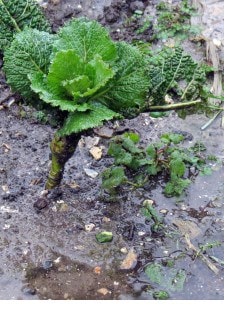What to do with a flood damaged veg plot

Splosh, splosh, splosh
gurgle gurgle
drip drip drip drip
When they come to play the soundtrack of this winter, it will be definitely a bit sloshy!
There will be a spine-chilling, howling base line and the odd heart-stopping ripping crashing percussion as trees fall over, their roots fatally loosened in the dissolving soil.
So this is what climate change feels like. Not sure I like it much.
Even up on our windy little hill perched above the inland lake once known as the Somerset Levels (now rechristened the Bay of Taunton), any thought of gardening has long since been battered out of my head by the endless water cannons of horizontal rain.
I can’t say as much for my plants. Even our usually free-draining chalk is struggling to cope with this apocalyptic scale of deluge. It may only be a few cabbages and some sprout plants, more able than most to tough it out, but poor, sodden things, they’re drooping forlornly in their puddles of standing water in a state of stasis, neither growing nor dying.
But let’s not get maudlin: the mass drowning of garden plants by long spells under water is, on the whole, less of a catastrophe on the veg plot. After all, we sweep everything away and plant it all over again every year anyway.
The damage you need to worry about happens largely unseen, underground, where dead earthworms rot in anaerobic, lifeless soil once the waters recede.
So if your plot has spent much of the last five months looking like its owner has taken up aquaculture, here’s how to get it back up and on its feet again:
- find out if the groundwater might have become contaminated, say from sewage, while it was flooded (your local council should be able to tell you).
- if so, avoid eating crops standing at the time, and don’t grow food you eat raw (like salads) for a year or two afterwards: you can grow food that you’re going to cook, though
- stay off the soil till you’re sure it’s dried out – you’ll do more damage than good
- once you can start working it, your first priority is forking in well-rotted organic matter – and plenty of it
- sow green manures on any beds you’re not using right away to dry out the soil and bring it back to life
- feed plants in spring and mid-summer with a slow-release fertiliser until the soil gets its strength back
- if a drought follows the flood, permanent crops like fruit bushes and artichokes may need extra watering – ironically plants which have survived flooding are more prone to drought stress
- install raised beds so your plants’ roots are out of the water if – god forbid – this happens again.




